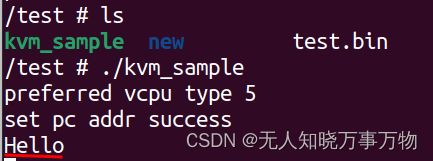linux虚拟化之kvm(一个200行的arm64虚拟机代码)
一、背景
之前介绍了X86上的一个简易虚拟机:
linux虚拟化之kvm(一个150行的x86虚拟机代码)-CSDN博客
,但作为一名嵌入式开发者,还是需要在ARM64上尝试一番,ARM64上的虚拟化和X86还是有很多差异点;本文介绍arm64下的基于kvm的虚拟机。
环境依赖:
1、X86下的qemu模拟arm64环境
qemu搭建arm64 linux kernel环境-CSDN博客
2、busybox 中增加基础lib库(libc),避免自己交叉编译的程序在arm64的Host OS下无法执行
将交叉工具编译链下libc相关的库也拷贝到busybox构建的rootfs 根目录即可,如我自己的交叉工具链下libc的路径:
/home/geek/tool/aarch64-none-linux-gnu/aarch64-none-linux-gnu/libc
二、arm64虚拟机架构
简单的说就是在X86电脑上用qemu模拟arm64的执行环境(Host OS),然后在arm64环境中通过kvm在虚拟机中执行一段简单的hello world汇编程序。
上图程序流程:
- 创建arm64 运行环境
- 通过/dev/kvm创建vcpu和设置USER_MEMORY
- 设置vpu type,
- 设置arm64的pc指针
- vcpu执行guest程序
- guest程序向地址0x996 写入"Hello"
- 由于这段地址非VM的memory空间,会触发KVM_EXIT_MMIO 事件
- 事件被host 端程序监听,通过kvm_run结构体信息提取 MMIO信息,获取到guest 程序写入的"Hello"字符
- host端通过printf串口输出
三、源码
1、arm64 host 代码(kvm_sample.c)
#include
#include
#include
#include
#include
#include
#include
#include
#define KVM_DEV "/dev/kvm"
#define MEM_SIZE 0x1000
#define PHY_ADDR 0x80000
#define AARCH64_CORE_REG(x) (KVM_REG_ARM64 | KVM_REG_SIZE_U64 | KVM_REG_ARM_CORE | KVM_REG_ARM_CORE_REG(x))
int main(void)
{
struct kvm_one_reg reg;
struct kvm_vcpu_init init; //using init the vcpu type
struct kvm_vcpu_init preferred;
int ret;
__u64 guest_entry = PHY_ADDR;
__u64 guest_pstate;
int kvmfd = open(KVM_DEV, O_RDWR);
//ioctl(kvmfd, KVM_GET_API_VERSION, NULL);
//1. create vm and get the vm fd handler
int vmfd = ioctl(kvmfd, KVM_CREATE_VM, 0);
//2. create vcpu
int vcpufd = ioctl(vmfd, KVM_CREATE_VCPU, 0);
if(vcpufd < 0) {
printf("create vcpu failed\n");
return -1;
}
//3. arm64 type vcpu type init
//sample code can check the qemu/target/arm/kvm64.c
memset(&init, 0, sizeof(init));
//init.target = KVM_ARM_TARGET_GENERIC_V8; //here set KVM_ARM_TARGET_CORTEX_A57 meet failed
init.target = -1;
if (init.target == -1) {
ret = ioctl(vmfd, KVM_ARM_PREFERRED_TARGET, &preferred);
if(!ret) {
init.target = preferred.target; //KVM_ARM_TARGET_GENERIC_V8
printf("preferred vcpu type %d\n", init.target);
}
}
ret = ioctl(vcpufd, KVM_ARM_VCPU_INIT, &init);
if(ret < 0) {
printf("init vcpu type failed\n");
return -1;
}
//4. get vcpu resouce map size and get vcpu kvm_run status
int mmap_size = ioctl(kvmfd, KVM_GET_VCPU_MMAP_SIZE, NULL);
if(mmap_size < 0) {
printf("get vcpu mmap size failed\n");
return -1;
}
struct kvm_run *run = mmap(NULL, mmap_size, PROT_READ | PROT_WRITE, MAP_SHARED, vcpufd, 0);
//5. load the vm running program to buffer 'ram'
unsigned char *ram = mmap(NULL, MEM_SIZE, PROT_READ | PROT_WRITE,
MAP_SHARED | MAP_ANONYMOUS, -1, 0);
int kfd = open("test.bin", O_RDONLY);
read(kfd, ram, MEM_SIZE);
struct kvm_userspace_memory_region mem = {
.slot = 0,
.flags = 0,
.guest_phys_addr = PHY_ADDR,
.memory_size = MEM_SIZE,
.userspace_addr = (unsigned long)ram,
};
//6. set the vm userspace program ram to vm fd handler
ret = ioctl(vmfd, KVM_SET_USER_MEMORY_REGION, &mem);
if(ret < 0) {
printf("set user memory region failed\n");
return -1;
}
//7. change the vcpu register info, arm64 need change the pc value
// arm64 not support KVM_SET_REGS, and KVM_SET_SREGS only support at x86 ppc arch
// arm64 using the KVM_SET_ONE_REG
//sample code from qemu/target/arm/kvm64.c
reg.id = AARCH64_CORE_REG(regs.pc);
reg.addr = (__u64)&guest_entry;
ret = ioctl(vcpufd, KVM_SET_ONE_REG, ®);
if(ret < 0) {
printf("change arm64 pc reg failed err %d\n", ret);
return -1;
} else {
printf("set pc addr success\n");
}
//7. run the vcpu and get the vcpu result
while(1) {
ret = ioctl(vcpufd, KVM_RUN, NULL);
if (ret == -1)
{
printf("exit unknow\n");
return -1;
}
switch(run->exit_reason)
{
//when guest program meet io access error will trigger KVM_EXIT_MMIO event,
//using the event get guest program output
case KVM_EXIT_MMIO:
if (run->mmio.is_write && run->mmio.len == 1) {
printf("%c", run->mmio.data[0]);
}
break;
case KVM_EXIT_FAIL_ENTRY:
puts("entry error");
return -1;
default:
printf("exit_reason: %d\n", run->exit_reason);
return -1;
}
}
return 0;
} 2、arm64 kvm guest运行的代码(test.S)
/*
* write "Hello"(ASCII) to port 0x996
* compile:
*/
.section ".text"
start:
mov x5, 0x48
mov x4, 0x996
strb w5, [x4]
mov x5, 0x65
strb w5, [x4]
mov x5, 0x6c
strb w5, [x4]
strb w5, [x4]
mov x5, 0x6f
strb w5, [x4]
mov x5, 0x0a
strb w5, [x4]
ret3、链接文件(test.ld)
OUTPUT_ARCH(aarch64)
ENTRY(start)
SECTIONS
{
. = 0x80000;
.text : {*(.text)}
}4、makefile文件
INCLUDES = -I /home/geek/workspace/linux/linux-6.6.1/usr/include
CC=aarch64-none-linux-gnu-gcc
OBJCOPY=aarch64-none-linux-gnu-objcopy
LD=aarch64-none-linux-gnu-ld
all: test.bin kvm_sample
test.bin:test.S
$(CC) -nostdlib -nostartfiles -nostdinc -c test.S -o test.o
$(LD) -nostdlib test.o -T test.ld -o test.tmp.o
$(OBJCOPY) -O binary test.tmp.o test.bin
kvm_sample: kvm_sample.c
$(CC) $(INCLUDES) kvm_sample.c -g -o kvm_sample
clean:
rm kvm_sample test.bin *.oMakefile中的INCLUDES的内核头文件需要注意一下,需要指定为编译arm64 运行环境的路径,因为我们编译的kvm_sample是要在arm64 linux 下运行, 在构建arm64 linux kernel 运行环境时,使用命令:
make ARCH=arm64 CROSS_COMPILE=aarch64-none-linux-gnu- headers_install
即可在对应kernel目录下生成 ./usr/include 头文件,这个路径加入到测试程序头文件即可
5、执行结果
无图无真相,结果比较简单,虽然只是一个简单的Hello,但是背后的实现并不简单:
四、总结
最后总结下kvm的使用流程:
1、创建虚拟机:vmfd = ioctl(kvmfd, KVM_CREATE_VM, 0);
2、创建vcpu:vcpufd = ioctl(vmfd, KVM_CREATE_VCPU, 0);
3、初始化虚拟机内存:ioctl(vmfd, KVM_SET_USER_MEMORY_REGION, &mem);
4、运行vcpu:ioctl(vcpufd, KVM_RUN, NULL);
无论是arm64还是X86, 流程基本是一样的,差异点在CPU的pc值,CPU类型等参数设置上;上面的流程也和qemu的实现类似,这里的一个加起来200行左右的代码展示了一个VM的基本流程。可扩展的部分:guest程序也可以用c去编写,需要剥离对系统库的依赖(如libc等);guest对host 只有输出,可以通过设置寄存器设置参数传递,完成输入的实验等。
参考:
Documentation - Arm Developer
Documentation - Arm Developer

